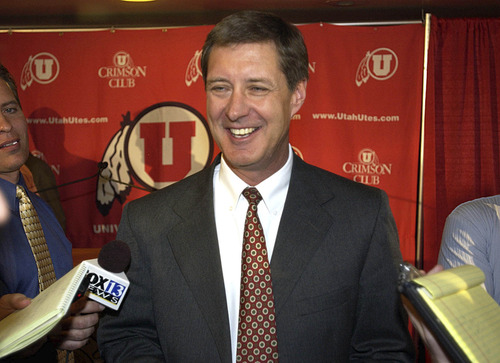This is an archived article that was published on sltrib.com in 2014, and information in the article may be outdated. It is provided only for personal research purposes and may not be reprinted.
On Thursday, the NCAA moved one step closer to granting its five most prominent Division I conferences the power to rule themselves on some of the most pressing issues facing the governing body of college sports.
After meeting in Indianapolis, the NCAA's Board of Directors announced they have endorsed the restructuring process for Division I that allows schools from the ACC, Big Ten, Big 12, SEC and Pac-12 to have a weighted autonomy over specific interests, which includes such hot-button issues as cost-of-attendance stipends and insurance policies to protect athlete's future earnings.
While such autonomy would be limited in scope and the NCAA won't formalize a new structure until August, the "Power Five" conferences are well on track to have more control over their subset of the NCAA. Utah athletic director Chris Hill is among those who welcomes such change.
"I think it's important to figure out how to provide student-athletes with more resources that will help them along the way," he said. "Those five conferences are a group that will more readily agree on those issues. It's an important change and it has big upside."
But some are more concerned about the limitations of that power.
In its news release, the NCAA said most agree the Power Five should be able to determine their own courses of action for cost-of-attendance stipends, insurance policies for athletes, and academic support among a few other perks.
But those outside those five conferences want to make sure the limits of that autonomy are spelled out specifically before the NCAA approves it. If the five power leagues are allowed to control such issues as roster size and transfer rules, it could diminish other schools' ability to compete.
Although most think some autonomy should be allowed, Utah State athletic director Scott Barnes said, it needs fine-tuning to make sure it doesn't slant the playing field.
"The devil's in the details in relation to those terms that still need to be discussed," Barnes said. "I'm not worried about using a helicopter to recruit with, but we have to be diligent as a non-big-five school and working toward holding on to some of those things that keep us competitive as best we can."
The NCAA will be gathering feedback throughout the spring to refine its proposal.
Among the structural changes being considered are an athletic council, featuring one representive from each Division I conference, to govern day-to-day policy and legislative responsibility. Most of those members would be athletic directors, but it would also include seats for both student athletes and conference commissioners.
Most Division I athletic directors, both Hill and Barnes agreed, see the proposed structure as a more nimble version of the existing hierarchy that can wipe out insignificant or outdated rules gathering dust in the NCAA guidelines. Increased student representation is also a plus, both mentioned, with Hill saying it could pave the way for some dramatic changes to how athletes are compensated.
Hill supports changes that would let student-athletes profit from their own likenesses. Incidents such as accusations that Johnny Manziel pocketed cash for signing autographs should be non-issues, he said. A restructured NCAA could make a harder push to allow such benefits. "If there's a[n] … athlete who has a chance to do something with their image such as signing autographs, I don't see any problem with it," Hill said.
The NCAA on Thursday also adopted a new transfer policy. Those who don't apply for immediate eligibility under a hardship waiver will get an extra year of eligibility after sitting out for the required period. Also, new guidelines were officially adopted to allow Division I schools to offer athletes unlimited meals and snacks.
Twitter: @kylegoon 'Power Five' may get more power
The NCAA is considering a proposal that would let the ACC, Big 10, Big 12, SEC and Pac-12 govern themselves in specific areas relating to student-athlete well-being. The NCAA says most agree these are the areas the conferences should be autonomous:
Financial aid • Including cost-of-attendance stipends and guaranteeing scholarships for more than one year.
Insurance • Including policies that protect future earnings of athletes that stand to make a windfall turning pro, ie. one-and-dones.
Academic support • Including offering more support to academically at-risk students.
Other support • Travel and free tickets to games for athletes' families.







